Background
Students, especially those with a passion for STEM, are strongly encouraged to explore new technologies. Yet, there is resistance from education systems to permit usage of Generative Artificial Intelligence (AI) systems, such as ChatGPT. At the time this article was written, the regulations surrounding AI use in schools could be quite strict, as the repercussions of employing such software can be as severe as expulsion from school.
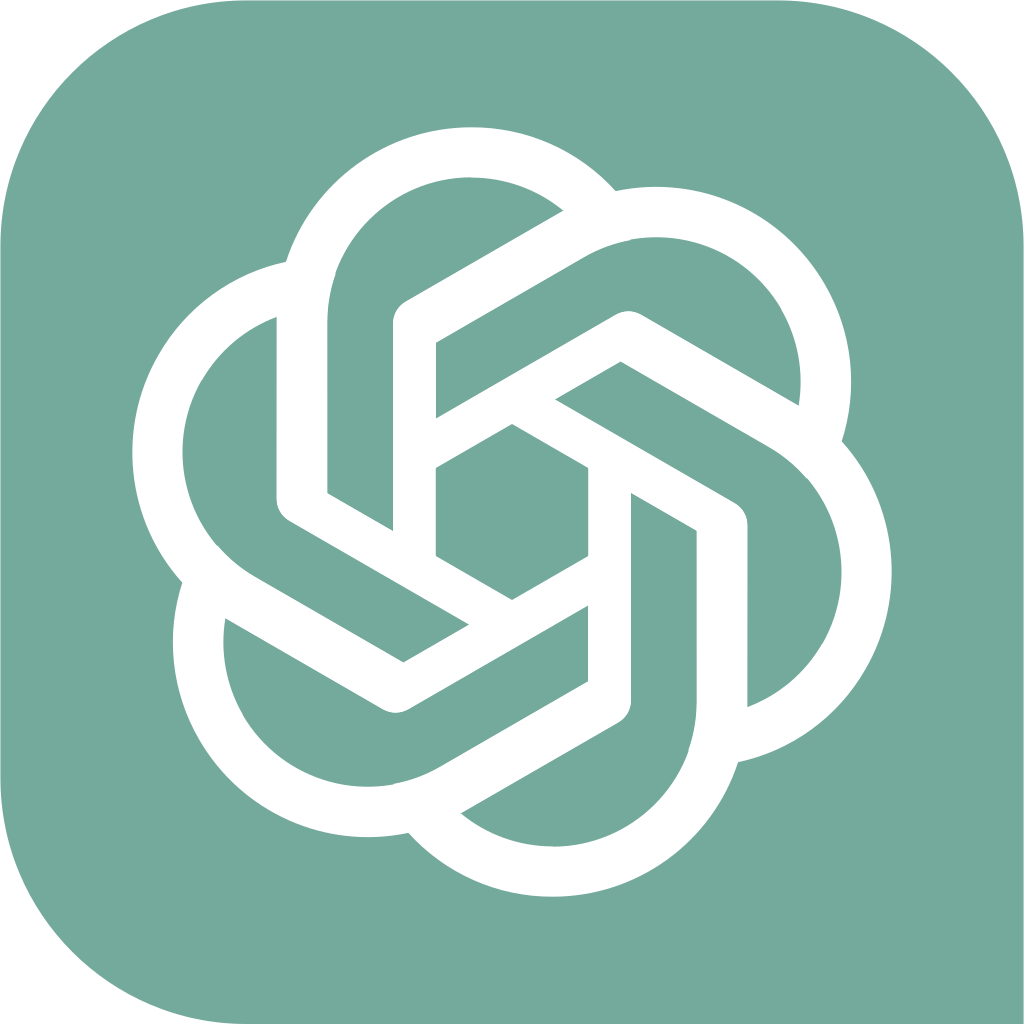
I would like to note that this exploration of AI technology arises in response to a practical design problem posed within an academic setting. Such an assignment develops the critical skill of grappling with contemporary real-world challenges while devising innovative solutions in preparation for the demands of a rapidly evolving professional landscape. This practical assignment demonstrates not only proficiency in design but also the ability to navigate complex regulatory frameworks and ethical considerations—a valuable skill set in industries like graphic design where emerging technologies play a pivotal role.
Executive Summary
Popular Science Magazine (PopSci) aims to redefine the role of AI systems in education. Misuse of AI technology has largely contributed to the negative narrative surrounding these systems; however, education of how to effectively use AI augmentation to assist with tasks in a productive way can revolutionize human potential.

Neographic Media was tasked with creating a magazine cover, depicting Generative AI as a tool for productivity rather than as a threat to academic growth among students.
Client Goals
- Encourage the exploration and education of new technologies
- Garner attention for PopSci Magazine
- Educate users on proper usage of Generative AI
By achieving these objectives, students will be inspired to embrace the current digital era, ensuring they maintain a competitive edge in the job market through their technological expertise. Ultimately, this initiative will empower individuals to utilize AI effectively, unlocking their full potential while emphasizing responsible and informed usage.
About the Magazine
PopSci stands as a popular U.S. magazine featuring insightful science reporting, cutting-edge technology updates, and engaging DIY projects. With its broad range of topics, PopSci caters not only to general readers but also to science enthusiasts, avid technology users, curious minds, and students seeking inspiration and knowledge.

In the digital realm, PopSci’s website has drawn 7.1 million visits on both desktop and mobile platforms within the past month alone (as of May 2024). This online presence has secured its standing, currently ranking at #93 in the competitive Programming and Developer software category, according to data from similarweb.com.
One of PopSci’s defining features is its bold and visually captivating aesthetic, characterized by striking text, vivid imagery, and harmonious color palettes. The magazine’s distinct style captures the essence of its content, making it instantly recognizable and engaging for audiences worldwide.
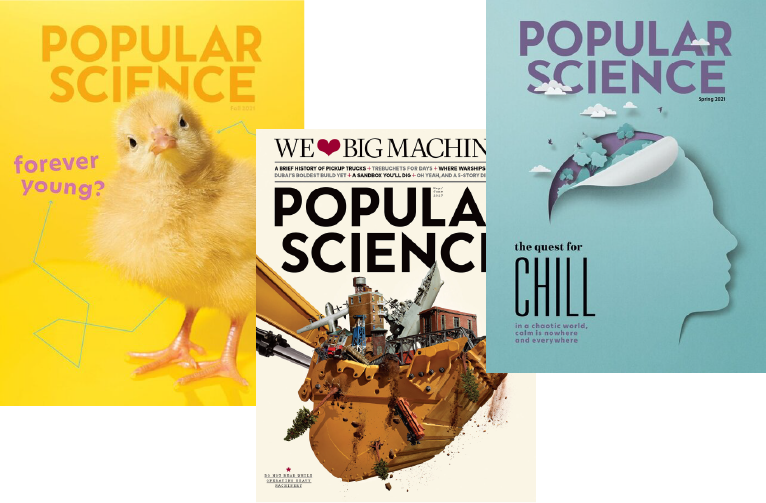
Given PopSci’s general content surrounding science and technology, a cover story addressing AI technologies only enhances its reputation for cutting-edge reporting, particularly by showcasing how tools like ChatGPT can revolutionize productivity and empower its readers to optimize their workflows and achieve a better work-life balance.
Design Challenges
The design challenge revolves around conceptualizing a dynamic 3D model for a magazine cover that transforms the perception of ChatGPT as a tool for productivity. This concept will empower students to optimize their workflows, accomplish tasks more efficiently, and reclaim precious time for their passions and relationships.
Design Objectives
- Adhere PopSci Magazine standards
- Appeal to PopSci’s target audience
- Develop a conceptual 3D model
Central to the design process is developing a deeper understanding of the target audience: students. By empathizing with their struggles, aspirations, and preferences, the conceptual model can be tailored to resonate with their needs and aspirations for enhanced productivity and work-life balance.
For this magazine cover design, I will utilize Cinema 4D, a 3D modeling software, to create a realistic model that also serves as a powerful metaphor. This task not only aligns with the magazine company’s mission to deliver compelling and innovative content but also challenges my visual communication skills by demanding the translation of abstract concepts into compelling, impactful imagery.
Process
As iteration is heavily emphasized throughout this post, it is only right to walk through the process it took to reach the final solution.
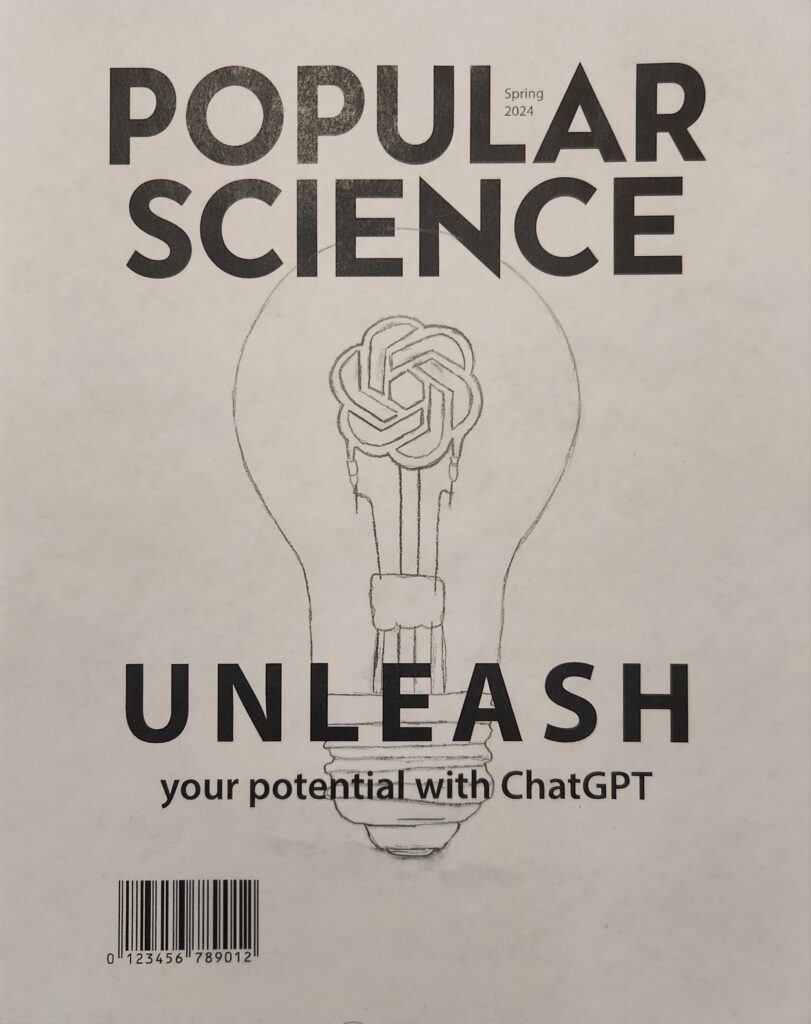
The light bulb serves as a universally recognized symbol of inspiration, innovation, and bright ideas. By replacing the filament within the bulb with the ChatGPT logo, the cover metaphorically communicates the idea that the AI system serves as the driving force behind students’ productivity. Similar to how the filament ignites the light bulb, ChatGPT ignites students’ potential, illuminating their paths to success.
Design Solution
The ultimate solution for PopSci’s cover features a visual metaphor, depicting the ChatGPT logo as the tungsten filament in a light bulb. This concept encapsulates the essence of ChatGPT’s potential to enhance productivity among students.
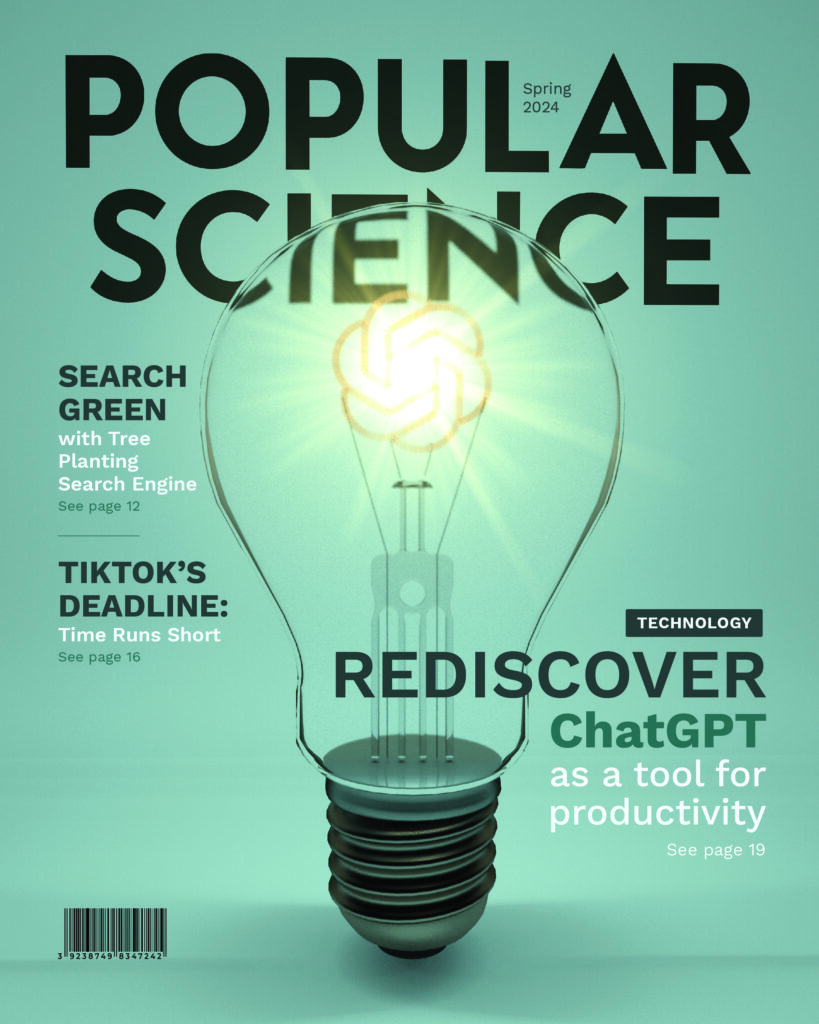
One of the key enhancements made during the design process was altering the initial concept of the filament. Originally, the filament was depicted as a solid ChatGPT logo. However, I refined this idea by transforming the filament to resemble the delicate, glowing structure of a real light bulb filament, while still maintaining the recognizable shape of the ChatGPT logo. This subtle yet significant change added a layer of realism and visual intrigue, making a world of difference in the overall design.
Breakthroughs
During this process, I experienced the following discoveries:
- The value of iteration in design.
- Arguably one of the most uncomfortable part of the design process is iteration. This discomfort stems from the acceptance that the initial concept may not have been as strong as the designer originally thought and the fear that the next attempt may not be better. However, seeking trusted feedback and saving all iterations can help counter these emotions and guide the design toward more successful outcomes. Exceptional design is about taking risks.
- The importance of visual storytelling in reshaping perceptions.
- Throughout history, art has been used to shape the perception of the masses. Common examples many may not consider is advertisements (add link to victorian broadside post). Propaganda is a form of advertising with the sole purpose of mass persuasion.
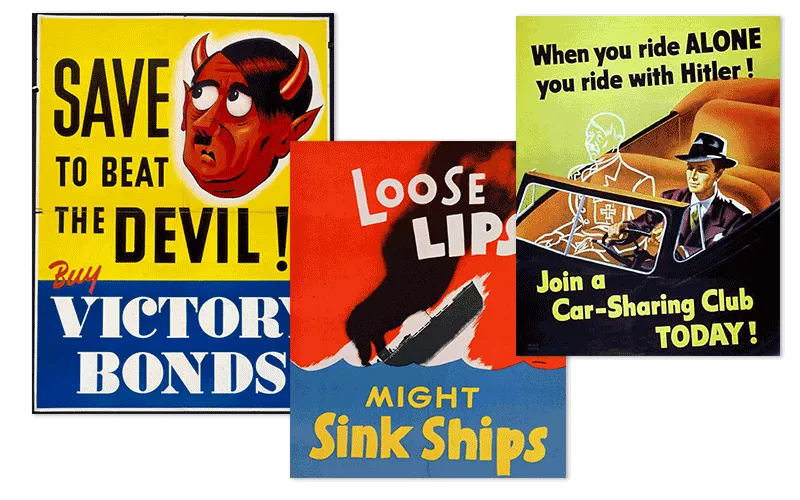
- The power to convey a message through imagery alone.
- The conceptual aspect of this design communicates a message through merely an image. There text is merely supplementary to the images. As a stand-alone model, the viewers can likely receive the same message.
Conclusions
The process of designing the PopSci magazine cover, with the ChatGPT logo as the filament in a light bulb, was both challenging and enlightening. This project will not only enhance the visual appeal of the magazine but also continue to solidify its reputation as a leader in cutting-edge technology reporting. By reimagining ChatGPT as a tool for productivity, the cover story effectively communicated the transformative potential of AI to a broad audience, including students and tech enthusiasts.
On a personal level, this project served as a prime opportunity for my growth as a designer. It pushed the boundaries of my visual communication skills, requiring a delicate balance between aesthetic appeal and functional clarity. Through advanced 3D modeling techniques and iterative design, I was able to translate abstract concepts into a compelling visual narrative.
Just take a look at the development from concept to creation:


Ultimately, my breakthroughs not only contributed to the success of this project but also provided valuable lessons for future endeavors. These insights will forever stay with me to inform my approach to design challenges, ensuring that I can continue to create impactful and engaging visuals. As I apply these lessons to future projects, I am confident that I will continue to develop as a designer, creating work that is both innovative and meaningful.
Want to see more?
Explore my portfolio for additional case studies and projects that showcase my skills graphic design and visual storytelling.
